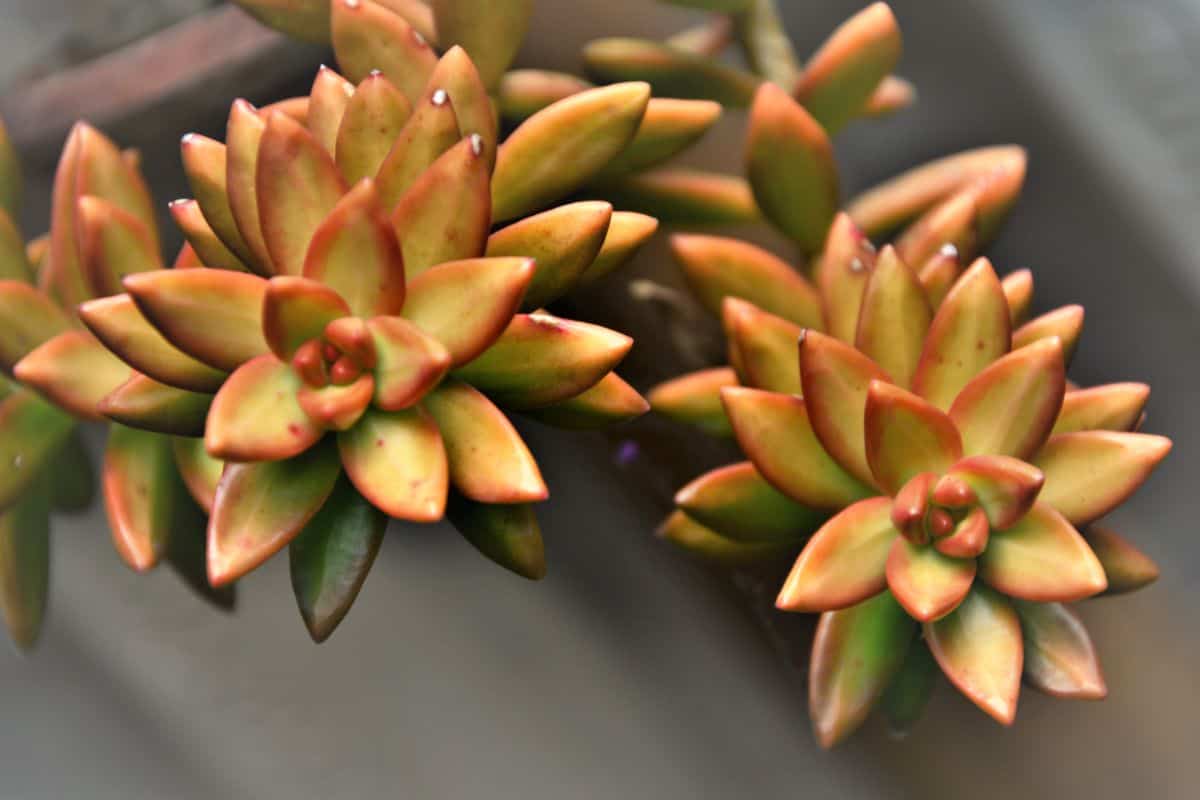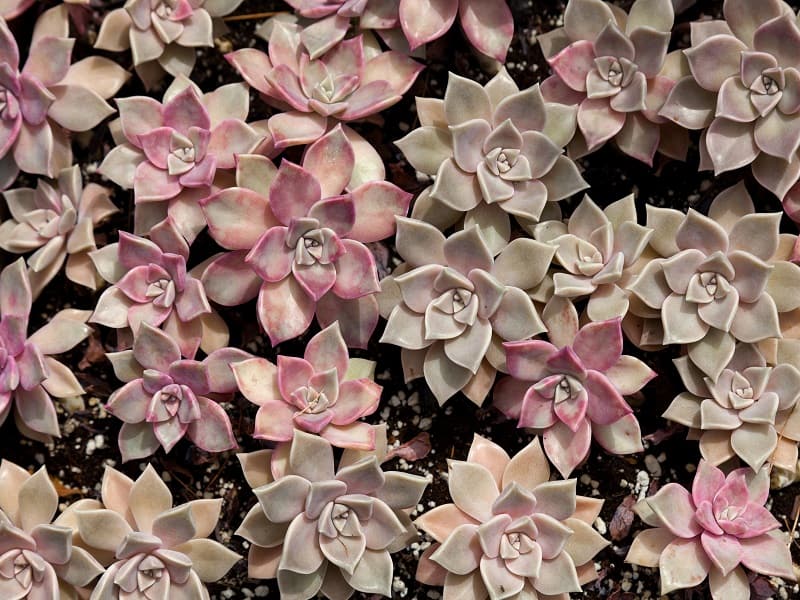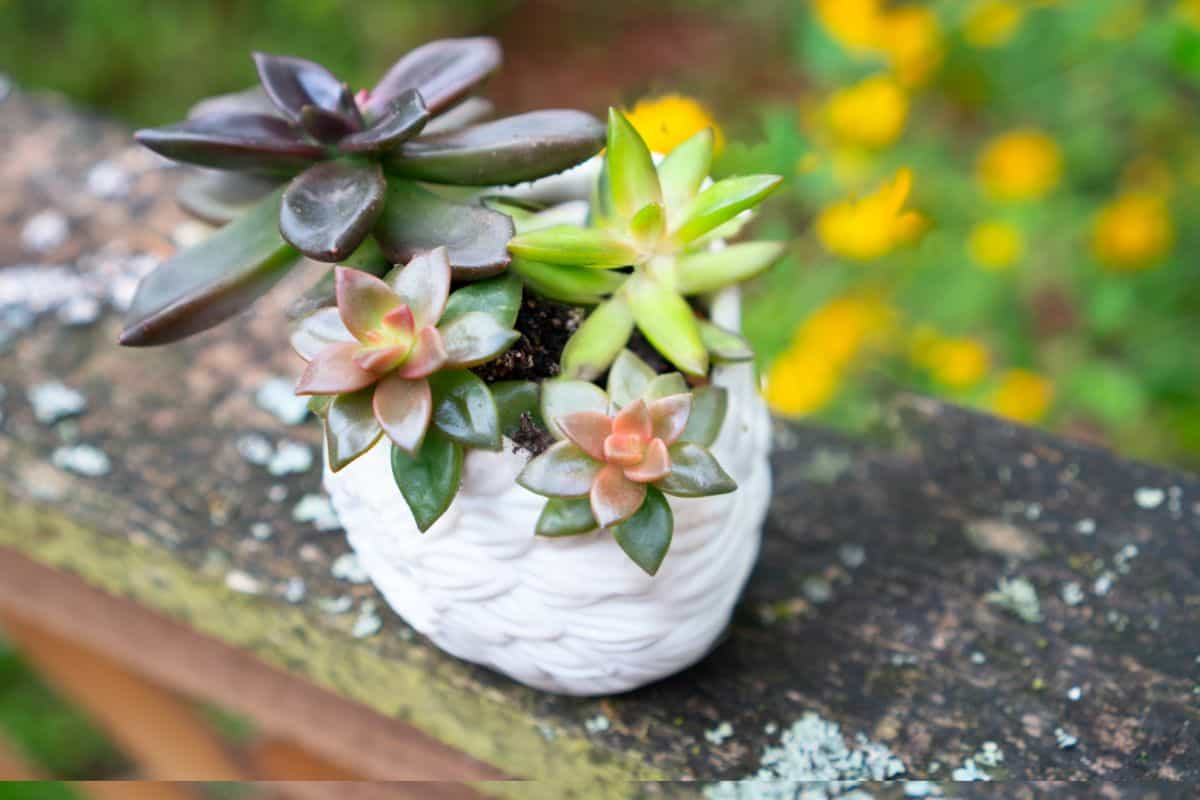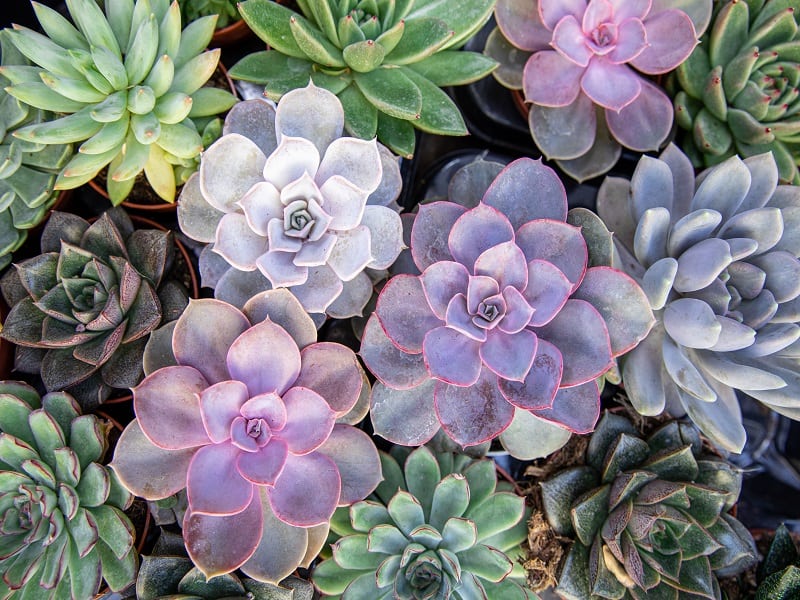The Graptosedum plant is otherwise known as the California sunset succulent, and we must say, we love the nickname! This is a hybrid plant that is a cross between the Graptopetalum paraguayense and Sedum adolphi.

This thick-leaved succulent doesn’t have the usual green leaves that most succulent plants have. Its leaves are thick and grow in a rosette formation, and its leaves are multiple shades of red, grey, and even purple.
California sunsets that grow in ideal conditions will produce delicate white flowers. If your succulent blooms, you can be sure that you are taking good care of your plant and that it isn’t under stress. Just like most succulent plants and cacti, these exotic plants need plenty of sunshine to develop their tropical colored leaves.
In this article, you will learn everything there is to know about the Graptosedum plant, from care to propagation, to fun and unusual facts about succulent plants. I will be referring to it as California sunset in this post as its scientific name is one hell of a mouthful! Enjoy!
Jump to:
- Care Guide
- Water
- Fertilizer
- Soil
- Sunshine
- Ideal Temperatures
- Ideal Growing Locations
- Propagation
- Offsets
- Seeds
- Leaves
- Buying Guide
- Roots
- Color and Appearance
- Age or Stage of Establishment
- Number of offsets
- Fun Facts About Succulents
- Succulents Make their Own Sunscreen
- Succulents Need to Be Introduced to the Sun
- Succulents Scar Easily
- Why are Succulents called Succulents?
- Over 60 Different Plant Families Contain Succulents
- Some Succulents are Colorful and Bright
- They Can Be Toxic to Animals
- They are Pest Resistant
- You can Propagate Your Succulent
Care Guide
| Name: | Graptosedum |
| Soil: | Porous sandy soil |
| Blooming: | Llate spring through early fall |
| Light: | Full sun to partial shade |
| Water: | When the soil is completely dry |
| Propagation: | Leaf cutting. offsets or seeds |
Although these succulents are easy to care for, they do have some very specific care needs that shouldn’t be forgotten. Follow the care guide below to ensure you are looking after your California sunset plant properly.
Water

If you are a keen gardener, you probably have a very strict watering schedule for your plants. California sunset succulents are more of a go-with-the-flow plant when it comes to watering and can not be treated like your other plants.
Use the ‘soak and dry’ watering method for California sunset succulents. I will explain step by step the soak and dry method for those of you that are unfamiliar with it.
- You will need to water your plant until you feel like the soil is damp all the way through.
- Touch the soil gently every morning to check its moisture levels. This can be done with your fingers, or if you are really well equipped, with a soil moisture detector.
- Do not water the soil until you feel that the soil is completely dry. Most people struggle with this, but remember, watering your plant when the soil is damp or wet will only cause it harm.
- Repeat the process.
- Your watering habits will change throughout the year. During the summer, you may find yourself watering the succulent weekly, while during the winter, your plant may need little to no water for months on end.
Fertilizer
California succulents do not need to be fertilized, but if you do choose to fertilize your plant, do so only once during the growing season. Here are a few signs to look out for that show that your plant could do with being fertilized:
- If your succulent is not producing flowers
- If your succulent is growing at a slower rate than expected for the season (only during the fall and spring)
- Look out for succulents that look malnourished
Soil
California sunset succulents thrive in porous sandy soil. Using dense potting soil is not appropriate for succulents as it will hold too much water and drown your succulent, or worse, cause its roots to rot. Well-draining soil is key for your succulent's survival.
Sunshine
The California sunshine succulent is not cold hardy. It loves the sunshine, and its leaves will turn a gorgeous burnt pink or red color when they are grown in a sunny spot.
No products found.
Ideal Temperatures
Graptopetalum California sunset plants will not survive in temperatures that are below freezing (more specifically, temperatures that get as low as 30° F or -1.1° C). California sunset plants should ideally be grown outside in containers that can be brought indoors whenever the weather is too harsh for them.
Ideal Growing Locations
Ideally, California sunsets should be grown outside in the full sun or partial shade. Not everyone lives in hot, sunny places that are good for growing succulents outside, and in these cases, placing your succulent on a sunny windowsill in the house is fine.
Propagation

Propagating California succulent plants is easy once you get the hang of it. Getting a ‘clean cut’ is key when propagating your plant.
Finally, a succulent that is easy to propagate! Do not be afraid to propagate your plant; after all, having the ability to make more plants to give to friends and family members is part of the fun.
You can propagate your succulent from offsets, leaves, and seeds. Practice makes perfect, and failure is a part of the process, so don’t be disappointed if it doesn’t work out the first couple of tries; it happens to us all!
Here is an overview of how to propagate your succulent using all of the methods:
Offsets
- Look out for small rosettes, or offsets, growing around the main stem of the plant.
- Remove the offset from the main stem with a sharp knife or pair of scissors.
- Let the offset dry out for two days.
- Place the offset in well-drained soil.
Seeds
You will only succeed in growing California sunset plants from seeds if the temperature is warm or growing them in a controlled environment with the help of grow lights.
- Sow the seeds in well-drained cactus soil.
- Use the ‘soak and dry’ method of watering.
- The most important step is patience. Germination can take weeks or even a month, so keep an eye on your seedlings for signs of growth.
Leaves
- Cut or twist a healthy leaf off the main stem.
- Make sure you don’t leave any of the leaves behind, as this will give you a better chance of success.
- Leave the leaf in a cool, dry place to dry out for a day.
- Place the leaf on well-drained soil.
Buying Guide

Shopping around for the right plant for you is a fun experience. Among all of the excitement of starting a new gardening project, you need to stay focused and look out for healthy plants with a high chance of succeeding in your garden.
Take a look at the buying guide below for tips and tricks and succulent shopping hacks to ensure you choose the healthiest succulent in the garden center. Take notes if you need to!
You May Also Like: Mammillaria Elongata AKA Ladyfinger Cactus - A Care Guide
Roots
If you can gently remove the plant from the pot to look at its roots, I highly recommend doing so. You need to look out for roots that are well established and tightly packed throughout the soil.
When you remove the plant from the pot, the soil should not crumble and fall from your hands if the plant has a strong root system. Instead, the soil will stay in a compact pot-shaped mass that is easy to place back in the pot.
A succulent that does not have a strong and established root system is not as strong as a succulent with strong, healthy roots. Keep this feature at the top of your list when looking for a healthy succulent.
Color and Appearance
Researching the type of succulent you want to grow prior to shopping around for them is an important step in the shopping process. Look out for succulents with discolored leaves or succulents that look soft and wilted as they may have underlying issues such as root rot.
Here are a few more telltale signs of an unhealthy plant:
- Black or brown stems
- Soft leaves
- Wilting
- Holes in the leaves or bugs around the base of the plant
Age or Stage of Establishment
Opting for the youngest plant isn’t always the best idea. Young plants are usually less established as many garden centers and greenhouses propagate their succulents as stock to sell to customers.
Look for a healthy-looking mature plant. This will give you the best chance of growing your succulent to its full potential with fewer hiccups along the way.
Number of offsets
Some plants have small offsets lurking around the base of the main stem. This is like finding gold in the world of gardening! Check for a healthy plant with offsets and if the plant meets the rest of the standards in this guide, buy it!
Fun Facts About Succulents

There is a lot to learn about these weird and wonderful plants, and of course, we aren’t going to be able to talk about them in detail in this short article. Here is what I found interesting about succulents; let’s see how much you already know about succulents, and if there are any more fun facts you want to share with us, feel free to do so in the comments section at the bottom of the article!
See Related Topic: Sempervivum Arachnoideum AKA Cobweb Houseleek: Complete Care Guide
Succulents Make their Own Sunscreen
Most succulent types are native to very hot desert-like regions of the world, and protecting their delicate fleshy leaves from the scorching sun is vital for their survival. Although they are sun-worshiping plants, they can only tolerate about six hours of full sun every day.
Succulents Need to Be Introduced to the Sun
What do I mean by introducing succulents to the sun? Well, succulents that have been bought from garden centers or greenhouses need to be introduced to a sunny environment very slowly so that they don’t go into a state of shock or burn.
You can do this by moving your succulent from shade to full sunshine and keeping it there for about four hours per day, and then moving the plant back to the shade. Increase the time spent in the sun by half an hour every day so that they get used to their new environment as quickly as possible. By the end of the week, your succulent will be completely climatized.
Succulents Scar Easily
Although succulents look very tough and tolerant, their leaves are delicate and soft. These plants do not have the ability to repair the damage done to their leaves completely, and any scars become permanent features.
Even touching the plant’s leaves with your fingers can leave a permanent fingerprint on the plant due to the oil from your fingers interfering with the leaves’ powdery substance. Because of this, you should avoid touching your succulent or spraying it with plant mists.
Why are Succulents called Succulents?
Succulents have thick, sap-filled leaves that are juicy, and well… succulent. They store moisture in their leaves, much like a camel stores water in its hump, so that they can survive doubt and hot weather.
Over 60 Different Plant Families Contain Succulents
Not only are there 60 different plant families that contain succulent plants, but there are also over 10,000 types of succulents growing in the wild and in gardens across the globe.
Some Succulents are Colorful and Bright
The most common color for succulent plants is green; however, succulents grow in pretty much every color of the rainbow. Some succulents need to be put under ‘healthy stress’ in order to develop red or pink tips on the top of their leaves, while other plants are grey or sunset-colored from the get-go.
They Can Be Toxic to Animals
Some types of succulents can be very toxic to cats and dogs. It is important to note that most succulent plants are not toxic; however, some can cause skin rashes, vomiting, diarrhea, and more serious reactions in rare cases if you have pets and are thinking about growing succulents in your home, research whether they are toxic or not beforehand.
They are Pest Resistant
They are almost always pest and disease resistant. Pests aren’t too keen on succulents, and in general, they avoid them completely. On occasion, you might find aphids lurking around your succulent if it is growing in the garden, but treatment is quick and easy.
One thing succulents are prone to is root rot. Root rot is caused by overwatering and can also come about if the succulent is planted in the wrong type of soil. Signs of root rot include wilting, yellowing of the leaves, and a soggy or spongy appearance.
You can Propagate Your Succulent
Using small cuttings from a parent plant, you can grow new plants and give them as gifts to friends and family. Propagating succulents is fun, although it takes a bit of practice to get to grips with the process.


